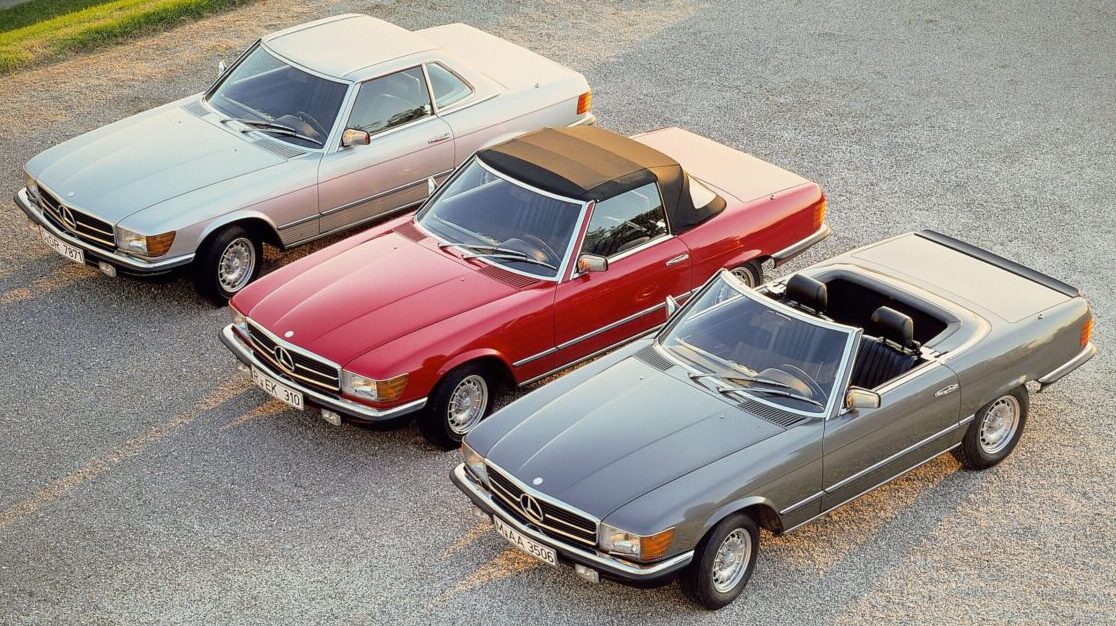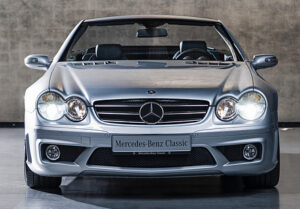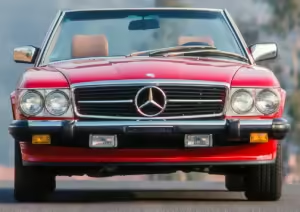Mercedes R107 SL vs R230 SL: Elegance beats convenience
5. Conclusion
Initial impressions
Switching from a modern Mercedes to the 1988 Mercedes-Benz R107 SL immediately highlights the sharp contrasts between the two. The classic Mercedes feels distinctly more compact, a reminder of a time when sports cars were designed to provide a more intimate driving experience. This difference becomes apparent the moment you settle behind the wheel. In the R107 SL, the driving position is closer to the dashboard, giving a more direct connection to the road, and the handbrake is positioned between the seats—a feature that evokes a sense of nostalgia in today’s world of high-tech convenience.
The Mercedes-Benz R107 SL, despite its age, offers a touch of luxury with its heated leather seats, wooden veneers, and basic electric windows. However, the sound system leaves much to be desired by modern standards.
Driving experience
The driving dynamics of the classic Mercedes-Benz R107 SL provide a surprising level of engagement. Although the car’s underpinnings show their vintage roots, the V8 engine delivers ample power and smooth performance. This power is enough to keep the classic Mercedes in line and corner safely, with a driving experience that feels both raw and refined.
On the other hand, the modern Mercedes-Benz R230 SL offers a different driving experience. The advanced crumple zones and automated systems of the R230 SL demonstrate significant advancements in safety and convenience. The driving feel is more detached compared to the classic R107 SL, which can be both a benefit and a drawback depending on what you’re seeking in a driving experience.
Convertible comparison
Both models share the convertible feature, yet their approaches differ markedly. The modern Mercedes-Benz R230 SL features a button-operated roof mechanism, showcasing the evolution of convenience and user-friendly design. In contrast, the classic Mercedes-Benz R107 SL requires a more intricate and manual process to operate its convertible roof—a process that can feel like a nostalgic puzzle.
Overall appeal
Despite their differences, both the modern Mercedes-Benz R230 SL and the classic R107 SL receive admiration for their unique qualities, which set each of them apart in the world of luxury cars. The Mercedes R107 SL, produced between 1971 and 1989, embodies the timeless elegance of a bygone era. Its sleek, minimalist design, coupled with vintage touches like wooden trim and simpler mechanics, transports drivers back to a time when cars were built to feel personal and intimate. This sense of nostalgia, paired with the car’s British-inspired charm, gives the R107 SL a unique character, one that appeals to those who appreciate the art of classic car craftsmanship.
On the other hand, the Mercedes R230 SL, with its production beginning in the early 2000s, is a testament to modern engineering and technological advancement. Packed with high-performance features and cutting-edge safety systems, it offers a completely different driving experience—one that prioritizes convenience, comfort, and effortless control. From its advanced suspension systems to the seamless operation of its convertible roof, the R230 SL showcases how far automotive technology has come. It’s a car designed for the driver who seeks performance without sacrificing luxury.
Comparing the two is like comparing different generations of a family. The R107 SL represents the wisdom, elegance, and simplicity of an earlier time, while the R230 SL stands as a symbol of progress, innovation, and modern luxury. Each generation has its own strengths: the R107 appeals to those who value history and craftsmanship, while the R230 caters to drivers seeking cutting-edge performance and comfort. Together, they represent the evolution of the Mercedes-Benz SL line, showing how the brand has successfully balanced tradition with innovation over decades of development.
Ultimately, whether you prefer the vintage allure of the R107 SL or the high-tech refinement of the R230 SL, both models have a place in the hearts of car enthusiasts. The key lies in appreciating the distinct qualities each car brings to the table, much like valuing the differences between older and younger generations.












